Numerical Study on the Long-Term Performance and Load Imbalance Ratio for Medium-Shallow Borehole Heat Exchanger System
Abstract
:1. Introduction
2. Methodology
2.1. OpenGeoSys
2.2. Coupling OpenGeoSys and TESPy
2.3. Load Imbalance Ratio
3. Model Configuration and Verification
4. Results
4.1. Single MSBHE
4.1.1. Influence of Depth
4.1.2. Influence of the Flow Rate
4.1.3. Influence of Operation Mode
4.2. MSBHE Array
4.2.1. Evolution of Temperature
4.2.2. Influence of Borehole Location on LIR
5. Discussion
5.1. Extended Numerical Simulation
5.2. Future Work
6. Conclusions
Author Contributions
Funding
Institutional Review Board Statement
Informed Consent Statement
Data Availability Statement
Conflicts of Interest
Abbreviations
| GSHP | Ground Source Heat Pump |
| BHE | Borehole Heat Exchange |
| DBHE | Deep Borehole Heat Exchange |
| FLS | finite line source |
| MSBHE | medium-shallow borehole heat exchange |
| 1U | single-U |
| 2U | double-U |
| CXC | coaxial with centered inlet |
| CXA | coaxial with annular inlet |
| OGS | OpenGeoSys |
| DC-FEM | dual-continuum finite element metho |
| TESPy | Thermal Engineering System in Python |
| LIR | load imbalance ratio (%) |
| accumulated heat imposed on the MSBHE (J) | |
| accumulated cooling supplied by the MSBHE (J) | |
| Q | shifted load (W/m) |
| P | proportion of shifted load (%) |
References
- Pramit, V.; Tanu, K.; Akhilesh, S.R. Energy emissions, consumption and impact of urban households: A review. Renew. Sustain. Energy Rev. 2021, 147, 111210. [Google Scholar] [CrossRef]
- Melike, E.B.; Seyit, M. Gökmenoğlu. Environmental pollution, hydropower energy consumption and economic growth: Evidence from G7 countries. Renew. Sustain. Energy Rev. 2017, 75, 68–85. [Google Scholar] [CrossRef]
- Jia, Z.J.; Lin, B.Q. How to achieve the first step of the carbon-neutrality 2060 target in China: The coal substitution perspective. Energy 2021, 233, 121179. [Google Scholar] [CrossRef]
- Arnulf, J.W.; Ioannis, K.; Nigel, T.; Christian, T. How photovoltaics can contribute to GHG emission reductions of 55% in the EU by 2030. Renew. Sustain. Energy Rev. 2020, 126, 109836. [Google Scholar] [CrossRef]
- Zhang, S.C.; Fu, Y.J.; Yang, X.Y.; Xu, W. Assessment of mid-to-long term energy saving impacts of nearly zero energy building incentive policies in cold region of China. Energy Build. 2021, 241, 110938. [Google Scholar] [CrossRef]
- Austin, A.; Behnaz, R. Geothermal technology: Trends and potential role in a sustainable future. Appl. Energy 2019, 248, 18–34. [Google Scholar] [CrossRef]
- Soltani, M.; Kashkooli, F.M.; Souri, M.; Rafiei, B.; Jabarifar, M.; Gharali, K.; Nathwani, J.S. Environmental, economic, and social impacts of geothermal energy systems. Renew. Sustain. Energy Rev. 2021, 140, 110750. [Google Scholar] [CrossRef]
- John, W.L.; Aniko, N.T. Direct utilization of geothermal energy 2020 worldwide review. Geothermics 2021, 90, 101915. [Google Scholar] [CrossRef]
- Zhao, X.G.; Wan, G. Current situation and prospect of China’s geothermal resources. Renew. Sustain. Energy Rev. 2014, 32, 651–661. [Google Scholar] [CrossRef]
- Xu, Y.S.; Wang, X.W.; Shen, S.L.; Zhou, A.N. Distribution characteristics and utilization of shallow geothermal energy in China. Energy Build. 2020, 229, 110479. [Google Scholar] [CrossRef]
- China Geological Survey, Ministry of Natural Resources; Department of New and Renewable Energy, National Energy. China Geothermal Energy Development Report; China Petrochemical Press: Beijing, China, 2018.
- Wang, F.H.; Cai, W.L.; Wang, M.; Gao, Y.; Liu, J.; Wang, Z.H.; Xu, H. Status and Outlook for Research on Geothermal Heating Technology. J. Refrig. 2021, 42, 14–22. [Google Scholar] [CrossRef]
- Cai, W.L.; Wang, F.H.; Chen, S.; Chen, C.F.; Liu, J.; Deng, J.W.; Olaf, K.; Shao, H.B. Analysis of heat extraction performance and long-term sustainability for multiple deep borehole heat exchanger array: A project-based study. Appl. Energy 2021, 289, 116590. [Google Scholar] [CrossRef]
- Li, J.; Xu, W.; Li, J.F.; Huang, S.; Li, Z.; Qiao, B.; Yang, C.; Sun, D.Y.; Zhang, G.Q. Heat extraction model and characteristics of coaxial deep borehole heat exchanger. Renew. Energy 2021, 169, 738–751. [Google Scholar] [CrossRef]
- Demba, N. Reliability and performance of direct-expansion ground-coupled heat pump systems: Issues and possible solutions. Renew. Sustain. Energy Rev. 2016, 66, 802–814. [Google Scholar] [CrossRef]
- Yang, W.B.; Chen, Y.P.; Shi, M.H.; Jeffrey, D.S. Numerical investigation on the underground thermal imbalance of ground-coupled heat pump operated in cooling-dominated district. Appl. Therm. Eng. 2013, 58, 626–637. [Google Scholar] [CrossRef]
- Qian, H.; Wang, Y.G. Modeling the interactions between the performance of ground source heat pumps and soil temperature variations. Energy Sustain. Dev. 2014, 23, 115–121. [Google Scholar] [CrossRef]
- Hou, G.Y.; Hessam, T.; Song, Y.; Jiang, W.; Chen, D.Y. A systematic review on optimal analysis of horizontal heat exchangers in ground source heat pump systems. Renew. Sustain. Energy Rev. 2022, 154, 111830. [Google Scholar] [CrossRef]
- Denis, G.; Ruchi, C.; Kenichi, S. Risk based lifetime costs assessment of a ground source heat pump (GSHP) system design: Methodology and case study. Build. Environ. 2013, 60, 66–80. [Google Scholar] [CrossRef]
- Ladislaus, R.; Walter, J.E. Sustainability aspects of geothermal heat pump operation, with experience from Switzerland. Geothermics 2010, 39, 365–369. [Google Scholar] [CrossRef]
- Ruiz-Calvo, F.; Cervera-Vázquez, J.; Montagud, C.; Corberán, J.M. Reference data sets for validating and analyzing GSHP systems based on an eleven-year operation period. Geothermics 2016, 64, 538–550. [Google Scholar] [CrossRef]
- Ruiz-Calvo, F.; Montagud, C. Reference data sets for validating GSHP system models and analyzing performance parameters based on a five-year operation period. Geothermics 2014, 51, 417–428. [Google Scholar] [CrossRef]
- Pan, S.; Kong, Y.; Chen, C.; Pang, Z.; Wang, J. Optimization of the utilization of deep borehole heat exchangers. Geotherm. Energy 2020, 8, 1–20. [Google Scholar] [CrossRef]
- Selvaraj, S.N.; Simon, J.R. Performance analysis of a large geothermal heating and cooling system. Renew. Energy 2018, 122, 429–442. [Google Scholar] [CrossRef] [Green Version]
- Adam, M.; Dante, F.; James, M.T.; David, J.H. Long-term district-scale geothermal exchange borefield monitoring with fiber optic distributed temperature sensing. Geothermics 2018, 72, 193–204. [Google Scholar] [CrossRef]
- Li, M.; Alvin, C.K.L. Review of analytical models for heat transfer by vertical ground heat exchangers (GHEs): A perspective of time and space scales. Appl. Energy 2015, 151, 178–191. [Google Scholar] [CrossRef]
- Yang, H.; Cui, P.; Fang, Z. Vertical-borehole ground-coupled heat pumps: A review of models and systems. Appl. Energy 2010, 87, 16–27. [Google Scholar] [CrossRef]
- Zhang, L.F.; Zhang, Q.; Huang, G.S. A transient quasi-3D entire time scale line source model for the fluid and ground temperature prediction of vertical ground heat exchangers (GHEs). Appl. Energy 2016, 170, 65–75. [Google Scholar] [CrossRef]
- Luo, Y.Q.; Yu, J.H.; Yan, T.; Zhang, L.; Liu, X.B. Improved analytical modeling and system performance evaluation of deep coaxial borehole heat exchanger with segmented finite cylinder-source method. Energy Build. 2020, 212, 109829. [Google Scholar] [CrossRef]
- Guo, Y.; Hu, X.; Banks, J.; Liu, W.V. Considering buried depth in the moving finite line source model for vertical borehole heat exchangers—A new solution. Energy Build. 2020, 214, 109859. [Google Scholar] [CrossRef]
- Louis, L.; Benoit, B. A new contribution to the finite line-source model for geothermal boreholes. Energy Build. 2007, 39, 188–198. [Google Scholar] [CrossRef]
- Mikael, P.; Michel, B.; Dominique, M. Validity ranges of three analytical solutions to heat transfer in the vicinity of single boreholes. Geothermics 2009, 38, 407–413. [Google Scholar] [CrossRef]
- Li, M.; Alvin, C.K.L. Analytical model for short-time responses of ground heat exchangers with U-shaped tubes: Model development and validation. Appl. Energy 2013, 104, 510–516. [Google Scholar] [CrossRef]
- Alberto, C.; Michela, C.; Nicola, M.; Alessandro, M. Models for thermo-fluid dynamic phenomena in low enthalpy geothermal energy systems: A review. Renew. Sustain. Energy Rev. 2016, 60, 330–355. [Google Scholar] [CrossRef]
- Perego, R.; Guandalini, R.; Fumagalli, L.; Aghib, F.S.; Biase, D.L.; Bonomi, T. Sustainability evaluation of a medium scale GSHP system in a layered alluvial setting using 3D modeling suite. Geothermics 2016, 59, 14–26. [Google Scholar] [CrossRef]
- Lee, C.K. Effects of multiple ground layers on thermal response test analysis and ground-source heat pump simulation. Renew. Sustain. Energy Rev. 2011, 88, 4405–4410. [Google Scholar] [CrossRef]
- Florides, G.A.; Paul, C.; Panayiotis, P. Single and double U-tube ground heat exchangers in multiple-layer substrates. Appl. Energy 2013, 102, 364–373. [Google Scholar] [CrossRef]
- Nam, Y.J.; Ryozo, O.; Suckho, H. Development of a numerical model to predict heat exchange rates for a ground-source heat pump system. Energy Build. 2008, 40, 2133–2140. [Google Scholar] [CrossRef]
- Luo, J.; Joachim, R.; Manfred, B.; Anna, P.; Xiang, W. Analysis on performance of borehole heat exchanger in a layered subsurface. Appl. Energy 2014, 123, 55–65. [Google Scholar] [CrossRef]
- Hu, X.C.; Jonathan, B.; Wu, L.P.; Liu, W.V. Numerical modeling of a coaxial borehole heat exchanger to exploit geothermal energy from abandoned petroleum wells in Hinton, Alberta. Renew. Energy 2020, 148, 1110–1123. [Google Scholar] [CrossRef]
- Li, C.; Guan, Y.L.; Liu, J.H.; Jiang, C.; Yang, R.T.; Hou, X.M. Heat transfer performance of a deep ground heat exchanger for building heating in long-term service. Renew. Energy 2020, 166, 20–34. [Google Scholar] [CrossRef]
- Luo, J.; Joachim, R.; Manfred, B.; Anna, P.; Lucas, W.; Xiang, W. Heating and cooling performance analysis of a ground source heat pump system in Southern Germany. Geothermics 2015, 53, 57–66. [Google Scholar] [CrossRef]
- Zhai, X.Q.; Cheng, X.W.; Wang, R.Z. Heating and cooling performance of a minitype ground source heat pump system. Appl. Therm. Eng. 2017, 111, 1366–1370. [Google Scholar] [CrossRef]
- Chen, S.; Francesco, W.; Olaf, K.; Shao, H.B. Shifted thermal extraction rates in large Borehole Heat Exchanger array—A numerical experiment. Appl. Therm. Eng. 2020, 167, 114750. [Google Scholar] [CrossRef]
- Bilke, L. OpenGeoSys Tutorial. Available online: https://www.opengeosys.org/docs/userguide/basics/introduction/ (accessed on 15 January 2022).
- Philipp, H.; Olaf, K.; Uwe-Jens, G.; Anke, B.; Shao, H.B. A numerical study on the sustainability and efficiency of borehole heat exchanger coupled ground source heat pump systems. Appl. Therm. Eng. 2016, 100, 421–433. [Google Scholar] [CrossRef]
- Francesco, W.; Ilja, T. TESPy: Thermal Engineering Systems in Python. J. Open Source Softw. 2020, 5, 2178. [Google Scholar]
- Bell, I.H.; Wronski, J.; Quoilin, S.; Lemort, V. Pure and Pseudo-pure Fluid Thermophysical Property Evaluation and the Open-Source Thermophysical Property Library CoolProp. Ind. Eng. Chem. Res. 2014, 53, 2498–2508. [Google Scholar] [CrossRef] [Green Version]
- Moldovan, D.; Peeters, F. Pybinding v0.8.0: A Python package for tight-binding calculations. Zenodo 2016. [Google Scholar] [CrossRef]
- Witte, F. TESPy Documentation. Available online: https://tespy.readthedocs.io/en/master/ (accessed on 20 January 2022).
- National Meteorological Information Center. Data Set of Monthly Standard Values of Surface Climate in CHINA (1981–2010). Available online: http://data.cma.cn/ (accessed on 10 February 2022).
- Zhou, Y.; Mu, G.X.; Zhang, H.; Wang, K.; Liu, J.Q.; Zhang, Y.G. Geothermal field division and its geological influencing factors in Guanzhong basin. Geol. China 2017, 44, 1017–1026. [Google Scholar] [CrossRef]
- Chen, S.; Cai, W.L.; Francesco, W.; Wang, X.R.; Wang, F.H.; Olaf, K.; Shao, H.B. Long-term thermal imbalance in large borehole heat exchangers array—A numerical study based on the Leicester project. Energy Build. 2021, 231, 110518. [Google Scholar] [CrossRef]
- Jakob, R.; Chen, S.; Katrin, L.; Steve, T.; Tom, R.; Karsten, R.; Rüdiger, G.; Anke, B.; Olaf, K.; Shao, H.B. Modeling Neighborhood-Scale Shallow Geothermal Energy Utilization-A Case Study in Berlin. Geotherm. Energy 2022, 10, 1–26. [Google Scholar] [CrossRef]
- Richard, A.B. Thermal response tests on deep borehole heat exchangers with geothermal gradient. Appl. Therm. Eng. 2020, 178, 115447. [Google Scholar] [CrossRef]
- GB50366; Technical Code for Ground-Source Heat Pump System. Ministry of Housing and Urban-Rural Development: Beijing, China, 2009.


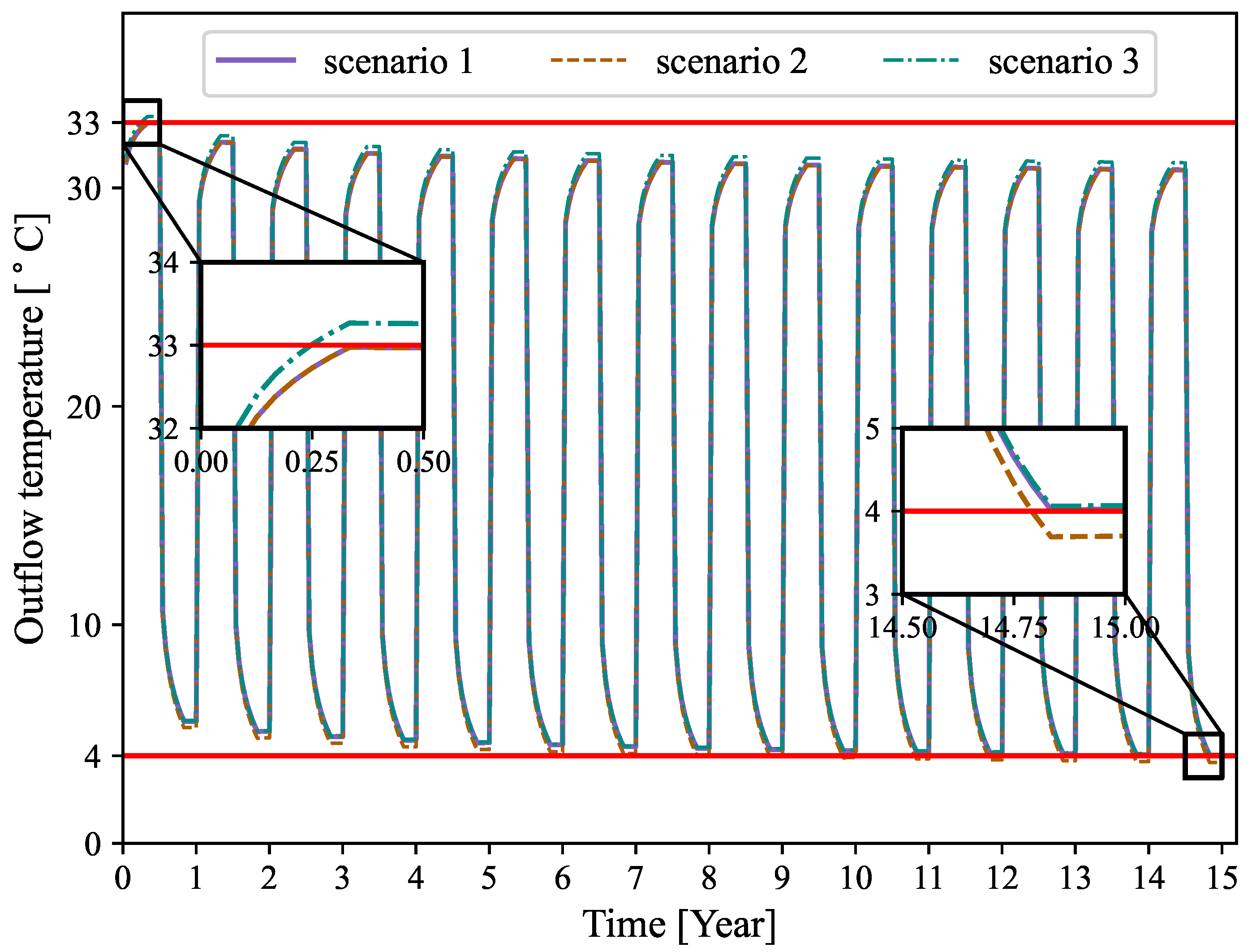
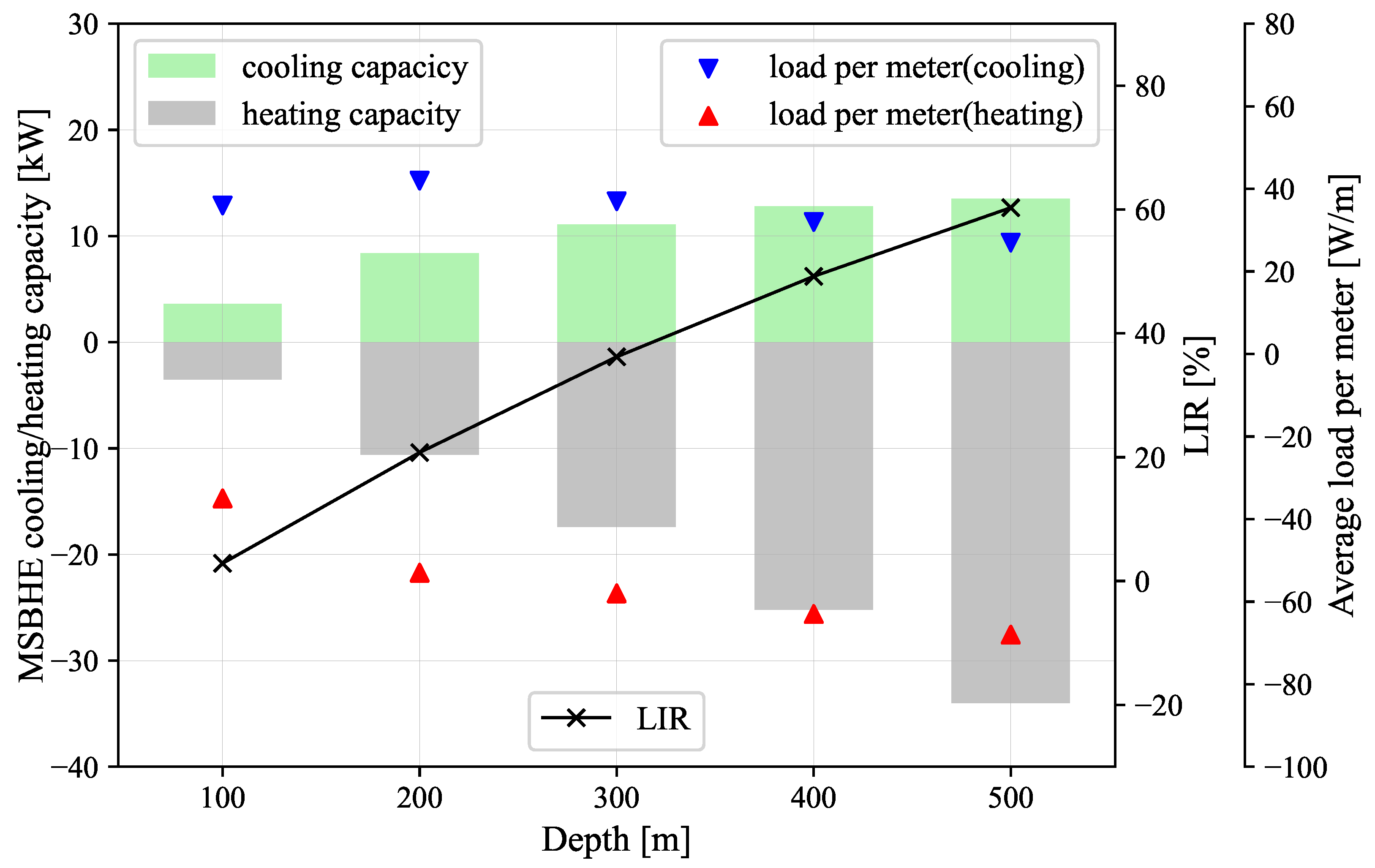

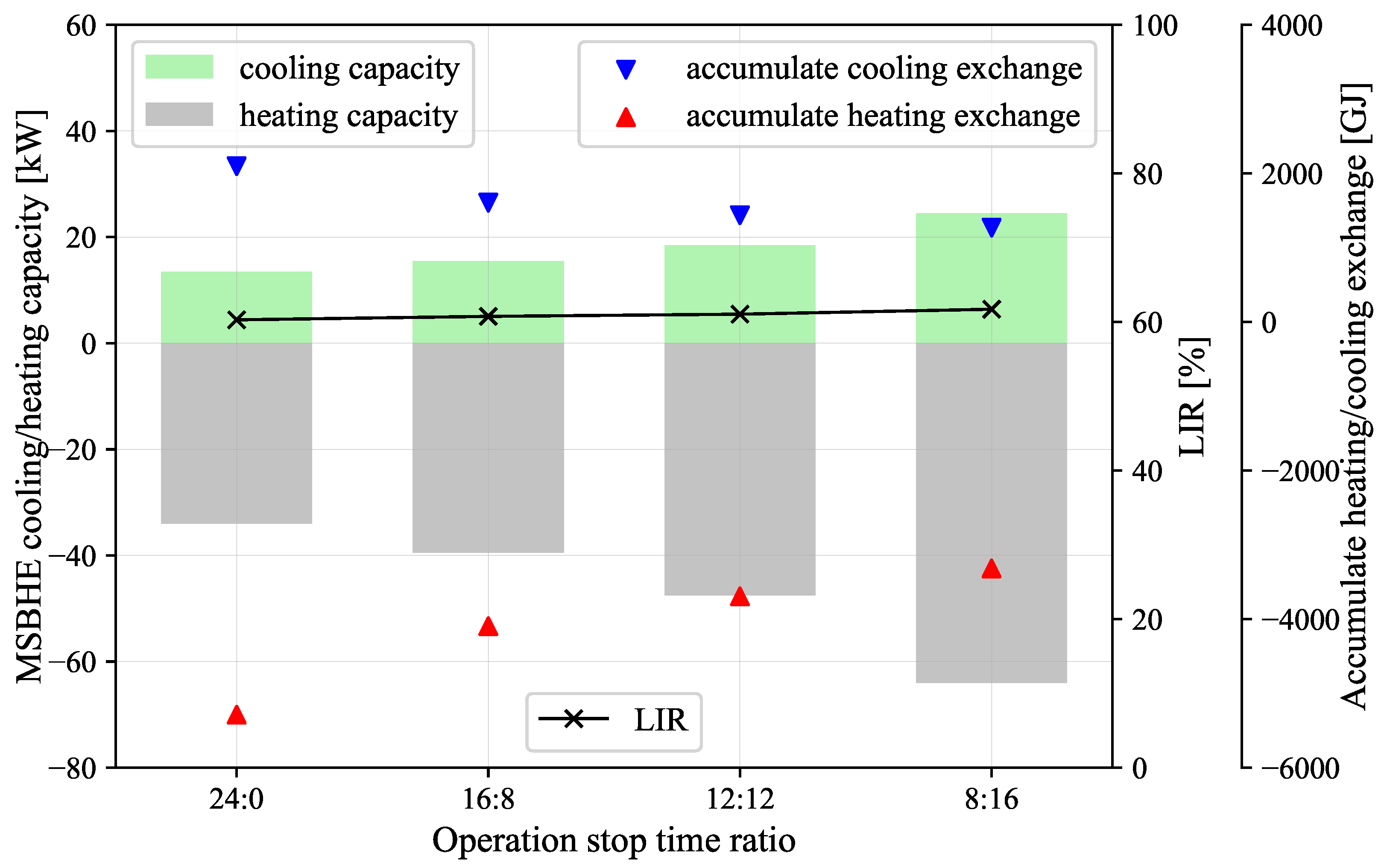
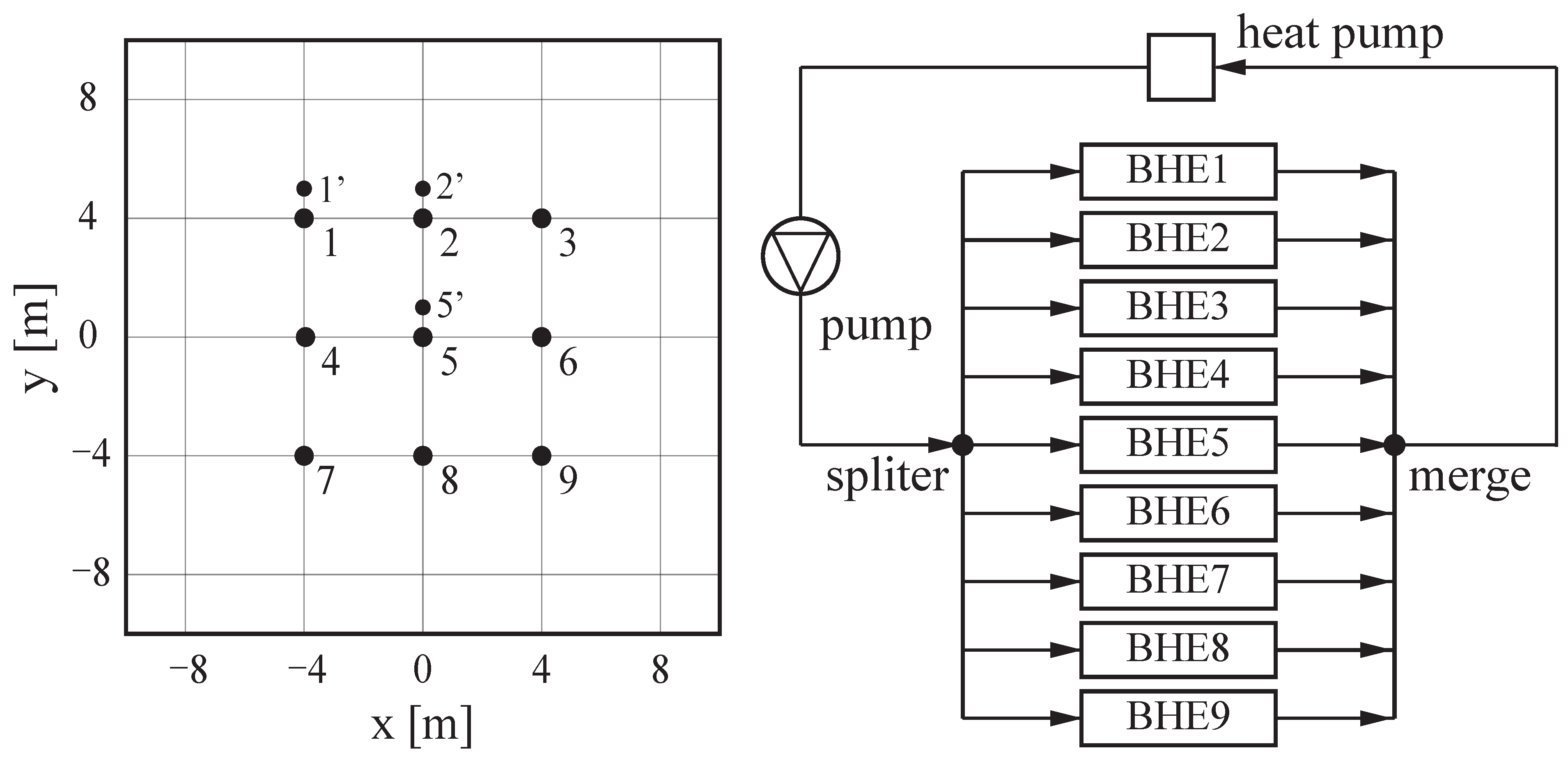
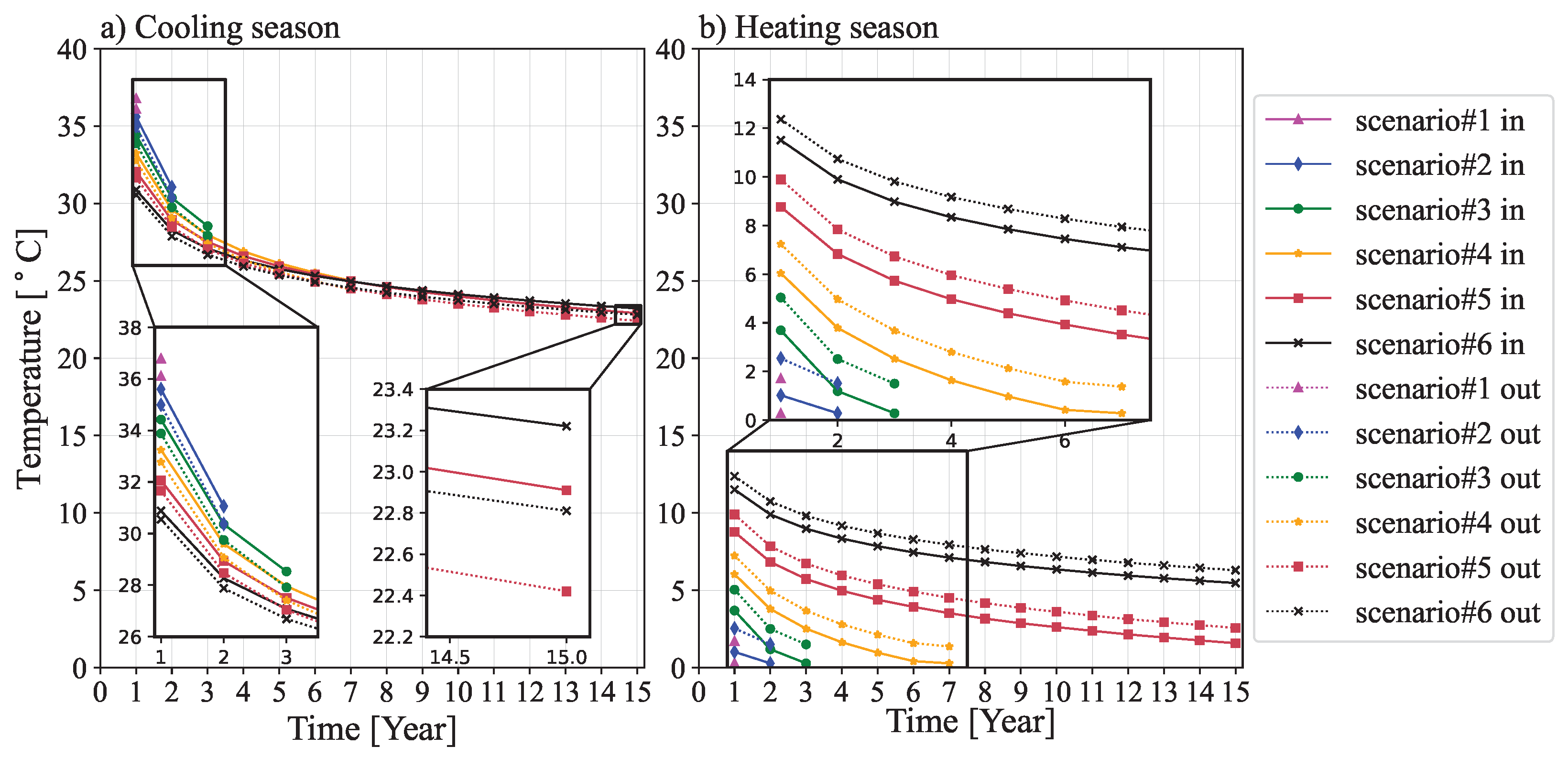
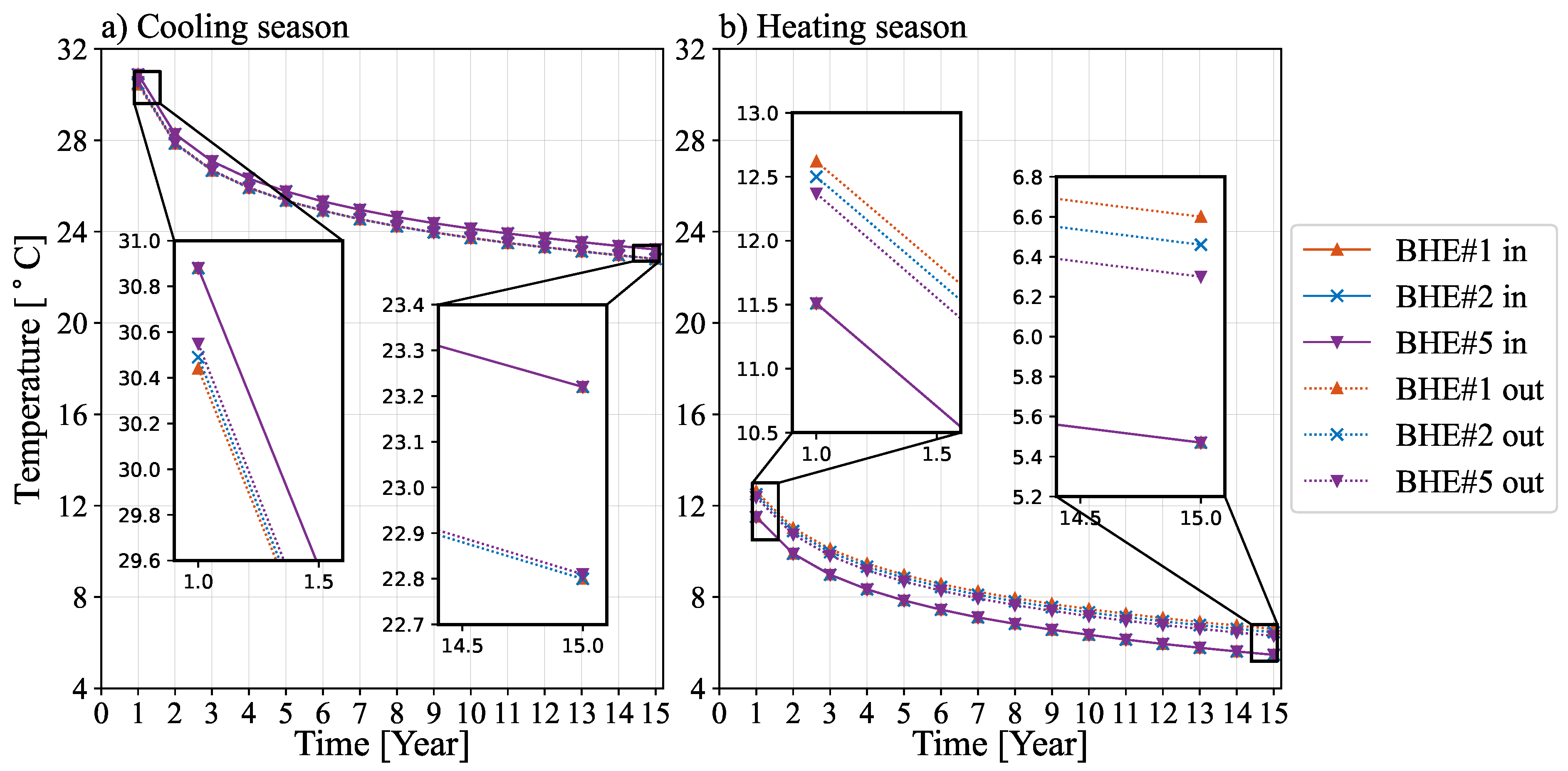

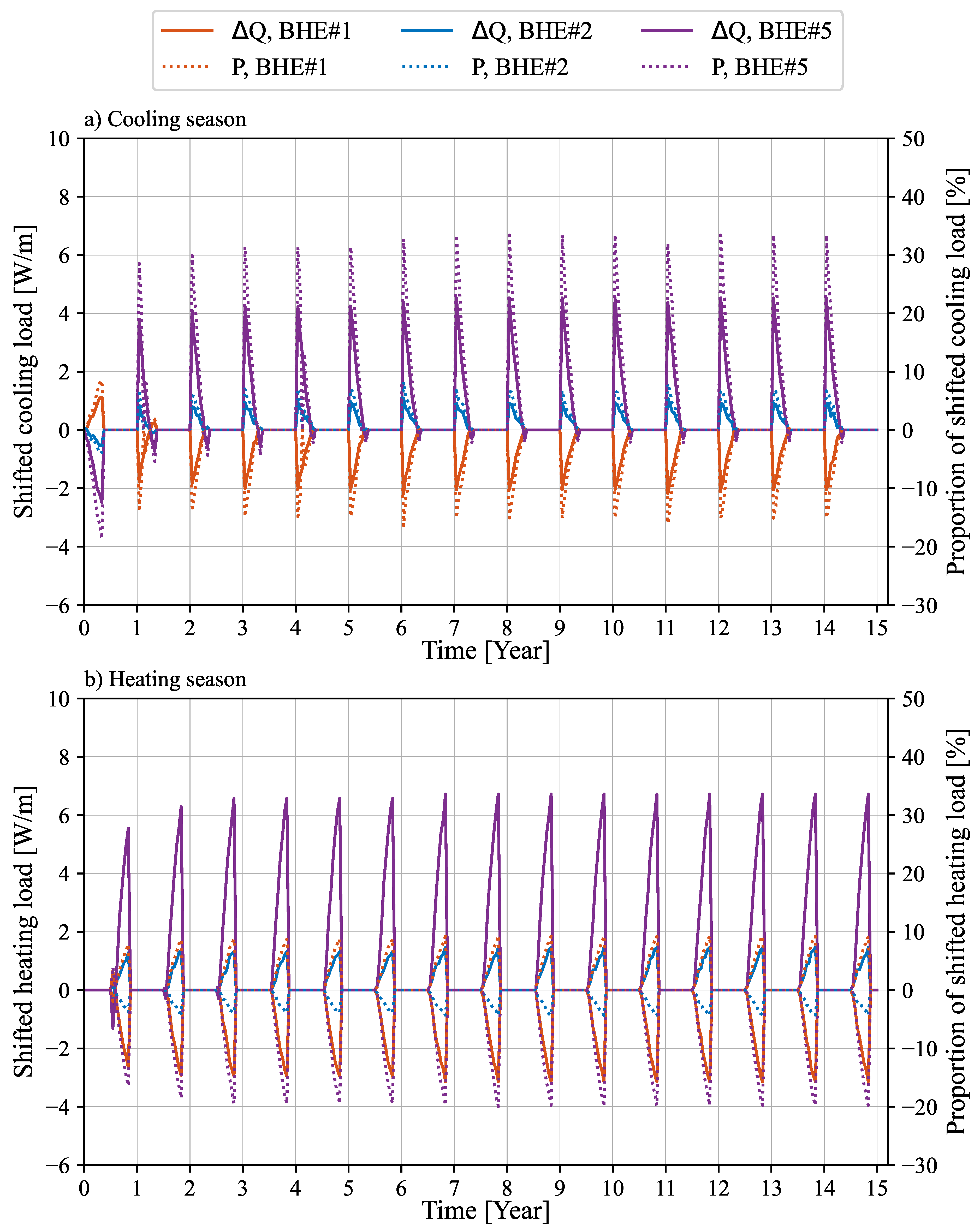

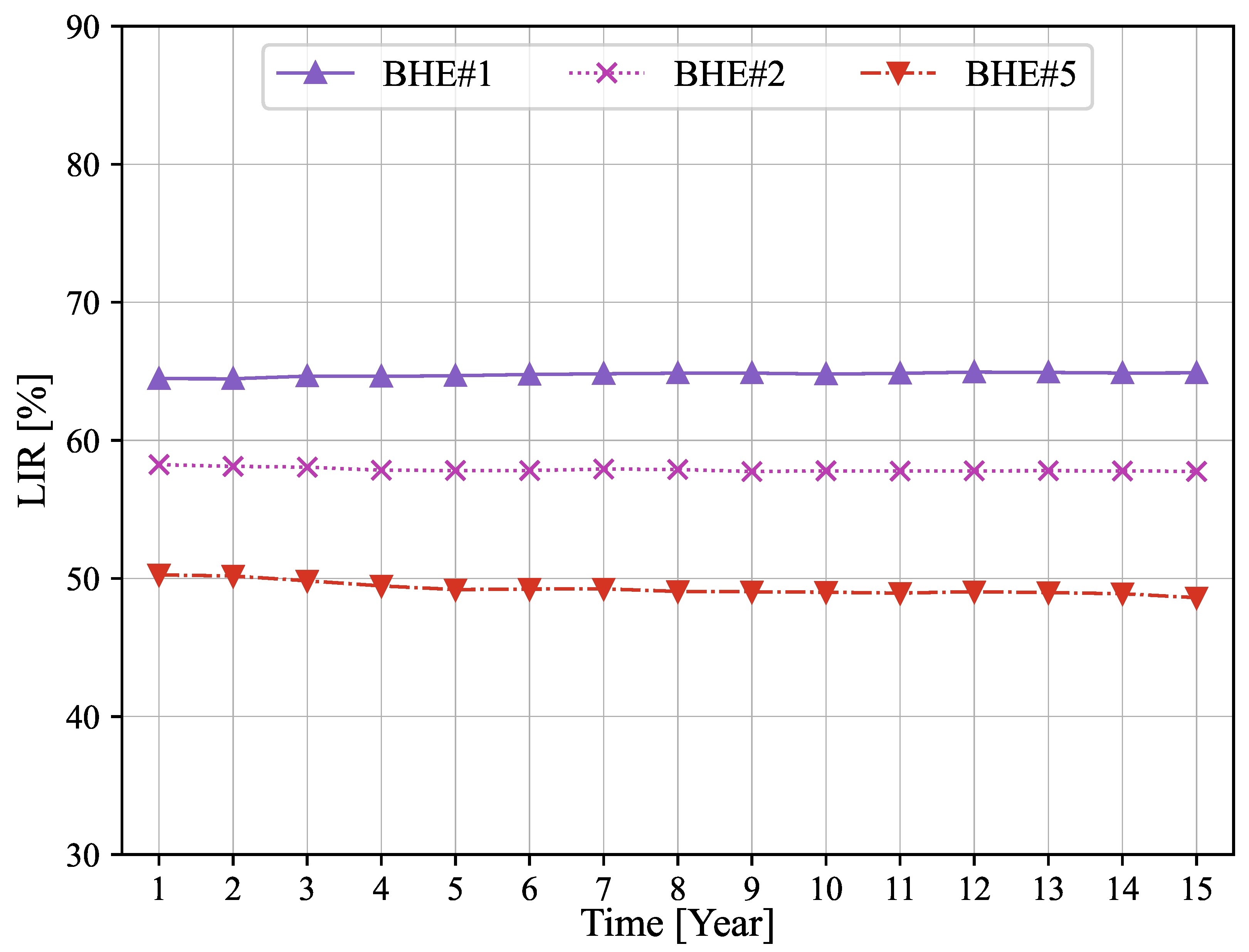
| Item | Parameter | Unit | Value |
|---|---|---|---|
| Borehole | depth | 500 | m |
| diameter | 0.15 | m | |
| Outer diameter of outer pipe | 0.1143 | m | |
| Outer diameter of inner tube | 0.042 | m | |
| Wall thickness of outer pipe | 0.00688 | m | |
| Wall thickness of inner tube wall | 0.01 | m | |
| Thermal conductivity of outer pipe wall | 14.48 | W m K | |
| Thermal conductivity of inner tube wall | 0.02 | W m K | |
| Grout | Density | 2190 | Kg m |
| Specific heat capacity | 1735.16 | J Kg K | |
| Thermal conductivity | 0.73 | W m K | |
| Circulating fluid | Density | 998 | Kg m |
| Specific heat capacity | 4190 | J Kg K | |
| Thermal conductivity | 0.6 | W m K | |
| Dynamic viscosity | 9.31 × 10 | Kg m s | |
| Subsurface | Geothermal gradient | 31.5 | C km |
| Soil density | 1120 | Kg m | |
| Soil specific heat capacity | 1780 | J Kg K | |
| Soil thermal conductivity | 2.4 | W m K |
| Item | Load in Cooling Season | Load in Heating Season | ||
|---|---|---|---|---|
| Per Meter (W m) | Total (kW) | Per Meter (W m) | Total (kW) | |
| scenario 1 | 27 | 13.5 | 68 | 34 |
| scenario 2 | 27 | 13.5 | 69 | 34.5 (+0.5) |
| scenario 3 | 28 | 14 (+0.5) | 68 | 34 |
Publisher’s Note: MDPI stays neutral with regard to jurisdictional claims in published maps and institutional affiliations. |
© 2022 by the authors. Licensee MDPI, Basel, Switzerland. This article is an open access article distributed under the terms and conditions of the Creative Commons Attribution (CC BY) license (https://creativecommons.org/licenses/by/4.0/).
Share and Cite
Wang, R.; Wang, F.; Xue, Y.; Jiang, J.; Zhang, Y.; Cai, W.; Chen, C. Numerical Study on the Long-Term Performance and Load Imbalance Ratio for Medium-Shallow Borehole Heat Exchanger System. Energies 2022, 15, 3444. https://doi.org/10.3390/en15093444
Wang R, Wang F, Xue Y, Jiang J, Zhang Y, Cai W, Chen C. Numerical Study on the Long-Term Performance and Load Imbalance Ratio for Medium-Shallow Borehole Heat Exchanger System. Energies. 2022; 15(9):3444. https://doi.org/10.3390/en15093444
Chicago/Turabian StyleWang, Ruifeng, Fenghao Wang, Yuze Xue, Jinghua Jiang, Yuping Zhang, Wanlong Cai, and Chaofan Chen. 2022. "Numerical Study on the Long-Term Performance and Load Imbalance Ratio for Medium-Shallow Borehole Heat Exchanger System" Energies 15, no. 9: 3444. https://doi.org/10.3390/en15093444
APA StyleWang, R., Wang, F., Xue, Y., Jiang, J., Zhang, Y., Cai, W., & Chen, C. (2022). Numerical Study on the Long-Term Performance and Load Imbalance Ratio for Medium-Shallow Borehole Heat Exchanger System. Energies, 15(9), 3444. https://doi.org/10.3390/en15093444








